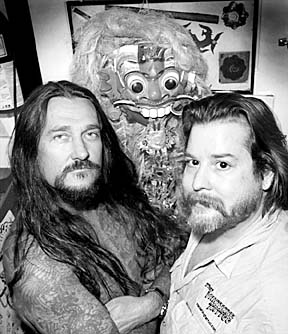| 02/14/2001
By Tom Zillich
Thanks to well-inked basketball freak Dennis Rodman and other
Hollywood/rock star types, tattoos are hip again. Nothing newsworthy
about that '90s trend.
What's significant these days is the lengths to which people will go
to have something of personal meaning tattooed on the ol' bod. For
Vince Hemingson, a trip to the local tattoo shop evolved into an
around-the-world tour in search of the history, rituals and social
importance of tribal tattoo art.
A post-divorce "mid-life crisis" brought him to a Davie Street shop
where he met well-traveled tattoo artist Thomas Lockhart, who
machine-inked Hemingson with a lion emblematic of his Scottish heritage.
"I was a bit of an unusual customer in that I spent so much time
researching my tattoos," says Hemingson. In his frequent trips to the
shop, he learned of Lockhart's tattoo-discovery journeys to exotic
locations.
"He told me about his trips to Everest, Mount Kilimanjaro, to the hill
tribes in the Philippines, and with the headhunters of Borneo who
tattooed him. As a filmmaker I really got to thinking that there's a
film here. Some people in the industry I talked to thought it was the
best idea for a documentary they'd heard about in 20 years."
Born was the idea for The Vanishing Tattoo, an in-progress film project
with the ambitious goal to film the oldest examples and the most
authentic and original practitioners of tattoo art—before they and
their art disappear for good.
Hemingson and Lockhart recently returned from a six-week, seven-country
trip to Southeast Asia, where they scouted locations and shot 10 hours
of film. Their pre-Christmas travels took them to Japan, Malaysia, New
Zealand, Australia, Samoa, Tahiti and back. Hemingson diarized the trip
on the award-winning www.vanishingtattoo.com website, launched in
September 1999 and now crammed with more than 1,000 pages of
tattoo-related script.
They met Japanese masters of tattoo art, and discovered a renaissance of
the art in places like Samoa. In Thailand, they experienced the more
spiritual side of tattoos done by monks.
"To them a tattoo is by its very
nature a magic tattoo," relates Hemingson. "At the Thai monastery we
were at, every March 1 everyone comes back to get their tattoo recharged
with this incredible 24-inch steel needle, and they do it one point at a
time. They get blessed beforehand, and after it's done the monk gives
you an incantation for you to repeat. Then he blows on the tattoo to
give it power. We got to meet the head monk because we were spending so
much money—500 baht notes at a time. And he blessed us a few times
just for the photo op."
top of page |
|

Photo: Doug Shanks
Vancouverites Thomas
Lockhart (left) and
Vince Hemingson teamed up in the Far East
to research their Vanishing Tattoo, a film
project that will consider the history, rituals
and social importance of tribal tattoo art.
Tattooing traditions are dying out in
some Far East regions, but not in Samoa and among the Maori in New
Zealand. Some of the traditional designs are gone, says Hemingson, but
people in those regions feel that you can't be Tahitian or Maori
unless you have a tattoo.
"There's a renaissance going on
that the rest of the world isn't aware of, really."
Lockhart, whose body is covered in a kimono-style tattoo, found that
many of the village elders who'd worked on him in the mid-'90s are
now dead. Those of the younger generation have tended to shun
traditional tattoos and tattooing in favour of machine-inked American
cultural icons such as eagles and Harley logos.
"In some places not only were the images fading, the traditional
method of hand-poking tattoos is lost to the electric tattoo
machines," Lockhart laments.
They have plans to discover tattoo artistry in regions of Russia and
Europe, and as close to home as Haida Gwai/Queen Charlotte Islands,
where many young aboriginals have no idea that the Haida were once
skilled tattooists.
The Vanishing Tattoo could expand from a 90-minute documentary into some
sort of TV series, given enough financial support. Already on board are
CanWest Global, The Aboriginal People's Network and BC Film.
"We're not anywhere near finished," sighs Hemingson. "When I
first started this I thought it'd be a quick-and-dirty little
documentary, but we've discovered a whole world of this stuff. We're
getting a tremendous amount of interest from academics who are realizing
that this is a human endeavor that's kind of been stigmatized in
western cultures which has viewed tattoos as the work of the lower
classes. For the rest of the world, tattoos are culturally important." |
